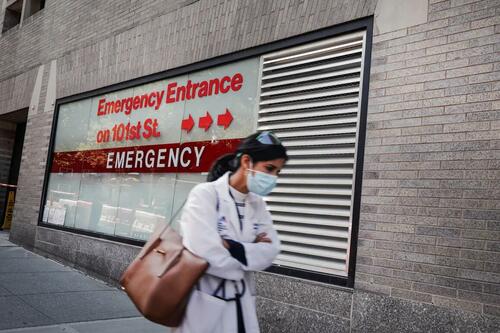What’s Behind America’s Doctor Crisis?
Authored by Autumn Spredemann via The Epoch Times (emphasis ours),

Securing an appointment to see a doctor in the United States is exacerbated by soaring health care demand and fewer doctors. Many specializations are increasingly affected by this trend, but primary care and emergency medicine are among the hardest hit.
The average wait time to see a doctor has increased since 2017 and continued to rise after the demand spike brought on by COVID-19. A survey conducted by AMN Healthcare in 2022 of 15 large metro markets revealed the average time to see a physician was 26 days—an 8 percent increase from 2017 and a 24 percent spike since 2004.
Staff constraints are also felt in hospital emergency departments. Nearly 140 million Americans visited a hospital emergency department in 2021, based on data from the Centers for Disease Control and Prevention. Of those, about 13 percent resulted in hospital admission; while thousands waited hours to see a health care provider.
Consequently, many patients leave before being seen by a doctor.
One study analyzed more than 1,000 hospitals between 2017 and the end of 2021 and found those with the worst performance had 4.4 percent of emergency room patients leave before a medical evaluation was conducted. At the end of 2021, that number had risen to upwards of 10 percent.
Compounding the issue is that nearly half of the doctor population will reach retirement age within the next 10 years and career burnout is hitting the rest harder than ever, according to data from Association of American Medical Colleges.
Almost 50 percent of doctors report that they feel burned out, according to a 2024 Medscape report.
These are key factors driving America’s growing scarcity of doctors. Physician Thrive’s 2023 study noted that the United States may have a shortage of 124,000 doctors by 2034. Within that shortfall, up to 48,000 will likely be lost from primary care, while the industry is projected to lose another 58,000 specialists, surgeons, and nurse practitioners.
“This is definitely coming down the pipeline. It’s been coming for a long time, and we’re seeing this all across health care,” emergency physician Dr. Jared Ross told The Epoch Times.
Dr. Ross is also president of Missouri-based Emergency Medical Services, Education & Consulting. He’s watched America’s health care worker crisis unfold on the front lines and says the shortage of physicians is an old problem that’s reached a tipping point.
“We’ve talked about this for years. It’s nothing new. There’s been a number of attempted stop-gap measures that haven’t been all that successful,” he said.
Some of these provisional solutions include bringing in more practitioners from foreign countries, medical school loan forgiveness programs, expanding telehealth services, and increasing the number of resident physician training supported by Medicare.
Dr. Ross has seen doctor shortages impact emergency medicine but maintains primary care has “really struggled” to retain physicians.
This is critical for two reasons. One is because health care demands in the United States are rising. The average number of times Americans visit a doctor per year by age group is four times for adults, nine for infants, and twice for children between the ages of five and 15, according to Vanguard Medical Group.
The other reason is due to what Dr. Ross called the “corporatization of medicine.”
“The problem is we have an insurance system that is a massive bureaucracy,” he said.
During a recent conference with other medical leaders, Dr. Ross said it was discussed how America has “really pushed away from the model of traditional health care.”
There was a general consensus within the group that insurance companies have become too powerful in medicine.
“The administrative burden or hassle, as many doctors describe it, is very disheartening,” Dr. William Schaffner, infectious disease specialist at the Vanderbilt University Medical Center, told The Epoch Times.
Having worked in medicine for more than 40 years, Dr. Schaffner has witnessed it evolve into something “aggressively more complicated” as insurance companies expand power over doctors. He says this trend became more noticeable by the 1990s.
“Doctors didn’t go to medical school in anticipation of arguing with insurance companies. It’s depressing and discouraging,” Dr. Schaffner said.
In 2020, for the first time, fewer than 50 percent of U.S. physicians worked in private practice, according to the American Medical Association (AMA). Most have chosen to become employees of large medical groups, which has drastically changed the paradigm of health care.
“The shift away from independent practices is emblematic of the fiscal uncertainty and economic stress many physicians face due to statutory payment cuts in Medicare, rising practice costs, and intrusive administrative burdens,” AMA President Dr. Jesse M. Ehrenfeld said in a 2023 statement.
Battling With Insurance
The move from independent practice to medical group employee presents its own dilemma. Aside from increased patient loads, it has left doctors at the mercy of having to get prior approval from insurance companies to carry out a medical treatment or procedure.
This forces a quantity-over-quality approach to treatment, according to Dr. Ross.
Prior authorizations are “an absolute headache,” he said. Physicians are now stuck battling with a third party who creates “as many roadblocks as possible because they don’t want to pay out.”
Dr. Schaffner said it took “numerous telephone conversations” with an insurance provider so a family member could get a necessary medical procedure done.
He said part of why it’s challenging is because there needs to be a level of trust on the insurance company’s end. “It’s not just a formal relationship that happens, but there also has to be a trust that develops with the benefits manager. It can take time,” Dr. Schaffner said.
Read more here…
Tyler Durden
Fri, 05/10/2024 – 10:55
via ZeroHedge News https://ift.tt/XdQv31Y Tyler Durden

